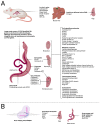Schistosome Transgenesis: The Long Road to Success
- PMID: 38248478
- PMCID: PMC10813141
- DOI: 10.3390/biology13010048
Schistosome Transgenesis: The Long Road to Success
Abstract
As research on parasitic helminths has entered the post-genomic era, research efforts have turned to deciphering the function of genes in the public databases of genome sequences. It is hoped that, by understanding the role of parasite genes in maintaining their parasitic lifestyle, critical insights can be gained to develop new intervention and control strategies. Methods to manipulate and transform parasitic worms are now developed to a point where it has become possible to gain a comprehensive understanding of the molecular mechanisms underlying host-parasite interplay, and here, we summarise and discuss the advances that have been made in schistosome transgenesis over the past 25 years. The ability to genetically manipulate schistosomes holds promise in finding new ways to control schistosomiasis, which ultimately may lead to the eradication of this debilitating disease.
Keywords: CRISPR; RNA interference; RNAi; functional genomics; genome editing; genomic safe harbour site; mobile genetic elements; schistosomiasis; transfection.
Conflict of interest statement
The authors declare no conflicts of interest.
Figures



 . The first larval stages of the parasite (miracidia) hatch from eggs (2) and seek out and penetrate specific snail intermediate hosts (3). In the snail, the miracidia develop into two consecutive generations of sporocysts (4), which produce large numbers of cercariae, the second larval form of the parasite (5). Cercariae are released from the snail and seek out and penetrate the skin of the human host (6). During penetration. they shed their forked tails to become schistosomulae (7). These juvenile worms migrate via the venous circulation to the lung and heart and finally develop in the liver (8) and (9). Male and female adult worms copulate and finally reside in the mesenteric venules of the bowel/rectum or the venous plexus of the bladder (10) (see
. The first larval stages of the parasite (miracidia) hatch from eggs (2) and seek out and penetrate specific snail intermediate hosts (3). In the snail, the miracidia develop into two consecutive generations of sporocysts (4), which produce large numbers of cercariae, the second larval form of the parasite (5). Cercariae are released from the snail and seek out and penetrate the skin of the human host (6). During penetration. they shed their forked tails to become schistosomulae (7). These juvenile worms migrate via the venous circulation to the lung and heart and finally develop in the liver (8) and (9). Male and female adult worms copulate and finally reside in the mesenteric venules of the bowel/rectum or the venous plexus of the bladder (10) (see  ,
,  , and
, and  for specific locations depending on schistosome species) [10].
for specific locations depending on schistosome species) [10].

Similar articles
-
Clusters of polymorphic transmembrane genes control resistance to schistosomes in snail vectors.Elife. 2020 Aug 26;9:e59395. doi: 10.7554/eLife.59395. Elife. 2020. PMID: 32845238 Free PMC article.
-
Functional genomics approaches in parasitic helminths.Parasite Immunol. 2012 Feb-Mar;34(2-3):163-82. doi: 10.1111/j.1365-3024.2011.01306.x. Parasite Immunol. 2012. PMID: 21711361 Review.
-
Functional Genomics Tools for Haemonchus contortus and Lessons From Other Helminths.Adv Parasitol. 2016;93:599-623. doi: 10.1016/bs.apar.2016.02.017. Epub 2016 Apr 1. Adv Parasitol. 2016. PMID: 27238014 Review.
-
Progress with schistosome transgenesis.Mem Inst Oswaldo Cruz. 2011 Nov;106(7):785-93. doi: 10.1590/s0074-02762011000700002. Mem Inst Oswaldo Cruz. 2011. PMID: 22124549 Free PMC article. Review.
-
Manipulating the manipulators: advances in parasitic helminth transgenesis and RNAi.Trends Parasitol. 2007 May;23(5):197-204. doi: 10.1016/j.pt.2007.03.007. Epub 2007 Mar 23. Trends Parasitol. 2007. PMID: 17383233 Review.
Cited by
-
CRISPR-based functional genomics for schistosomes and related flatworms.Trends Parasitol. 2024 Nov;40(11):1016-1028. doi: 10.1016/j.pt.2024.09.010. Epub 2024 Oct 18. Trends Parasitol. 2024. PMID: 39426911 Review.
References
-
- WHO . Ending the Neglect to Attain the Sustainable Development Goals: A Road Map for Neglected Tropical Diseases 2021–2030. World Health Organization; Geneva, Switzerland: 2020.
-
- Tokplonou L., Nouatin O., Sonon P., M’po G., Glitho S., Agniwo P., Gonzalez-Ortiz D., Tchégninougbo T., Ayitchédji A., Favier B., et al. Schistosoma haematobium Infection Modulates Plasmodium falciparum Parasite Density and Antimalarial Antibody Responses. Parasite Immunol. 2020;42:e12702. doi: 10.1111/pim.12702. - DOI - PubMed
Publication types
LinkOut - more resources
Full Text Sources
Research Materials
Miscellaneous

